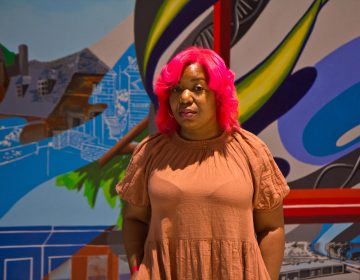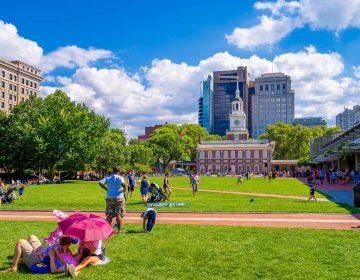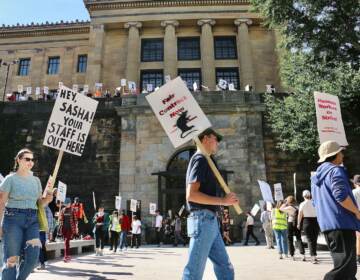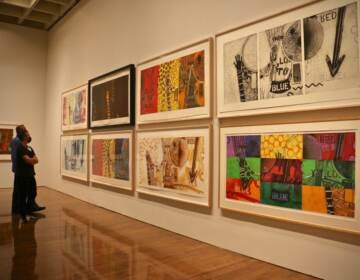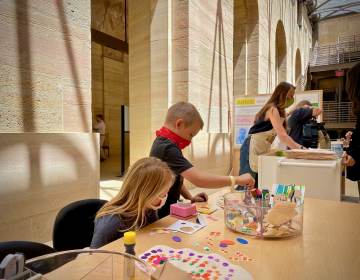Art Museum renovation changes the building, and perspectives
This weekend, the Philadelphia Museum of Art unveils its “Core Project,” a major renovation project four years in the making.
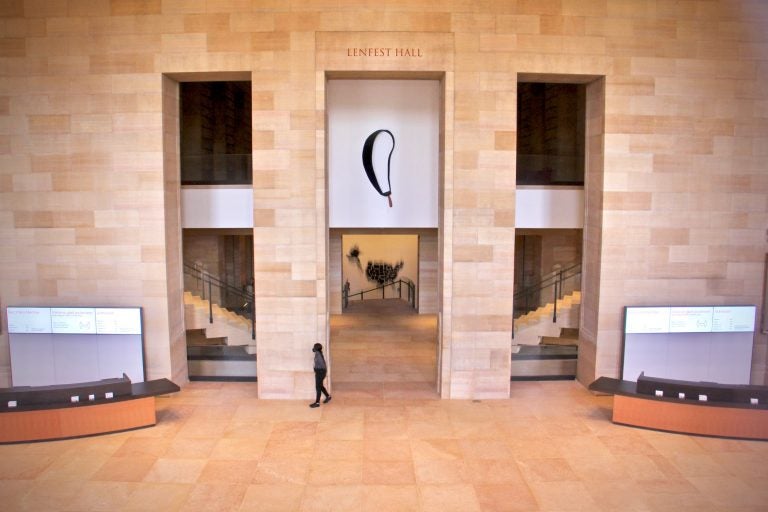
Redesigned Lenfest Hall at the Philadelphia Museum of Art West Entrance opens onto a soaring event space and new galleries. (Emma Lee/WHYY)
For decades, the Philadelphia Museum of Art has known it needed more space. Recently, architect Frank Gehry helped them realize they had the space they needed the whole time.
About 90,000 square feet has been carved out of what used to be staff office space and a vaulted corridor running underground for 640 feet, spanning the entire footprint of the museum, unused for nearly 50 years.
This weekend, the museum unveils its “Core Project,” a major renovation project four years in the making. The centerpiece is a forum space with 40-foot-high ceilings with a dramatic switchback staircase connecting the underground lower level to the first floor at the west entrance.
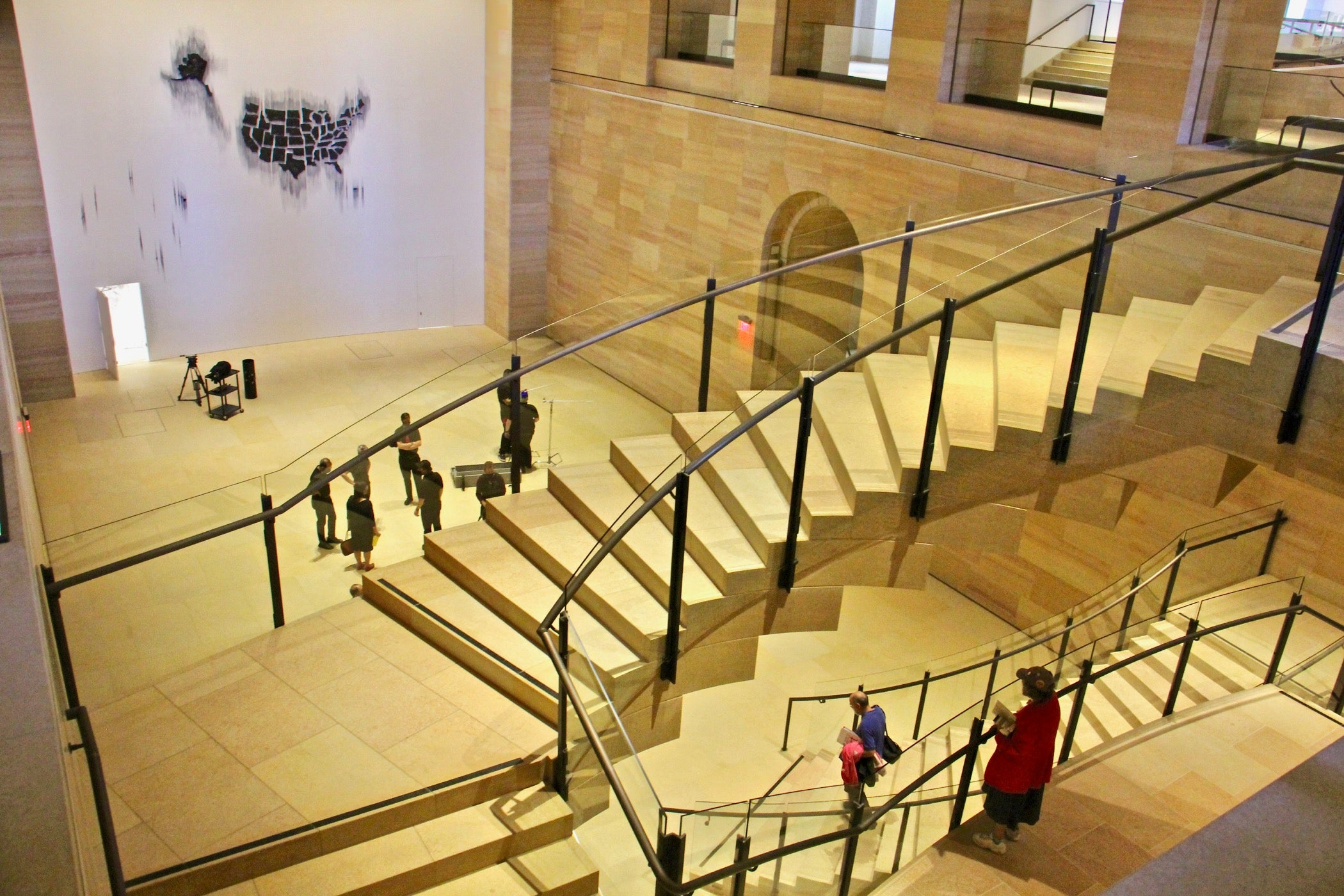
What used to be office spaces is now a gallery dedicated to contemporary art. What used to be the gift shop and restaurant is now an expansion of the museum’s Early American art galleries.
The renovations do not have any of the disruptive stylistic flair Gehry is often associated with, like the eye-popping geometric shapes of the Guggenheim Museum Bilbao in Spain and Museum of Pop Culture in Seattle.
Gehry took great care to make the new interior space seamless with the rest of the classically appointed Art Museum, designed in the 1920s by Horace Trumbauer, Julian Abele, Paul Cret, Clarence Zantzinger, and Charles Borie Jr. Gehry deferred to their century-old decisions, even sourcing the stone for the walls and floors from the same quarry in Minnesota. As a result, it appears the corridor, forum, and galleries have always been there.
The renovation needed to solve a few problems. The museum could be difficult to navigate, as visitors easily lost their sense of direction winding through the horseshoe-shaped building. Gehry decided that what was jamming up the space was the auditorium, built in 1959 in the center core, blocking an intuitive way to get across the building.
“[Gehry] often says, it’s the cork in the bottle that needed to come out,” said Gail Harrity, the museum chief operating officer who is stepping down now that the Core Project is complete. “So what he has done … is to remove an auditorium that was not ADA-compliant, not built for 21st-century programming, and create this new public gathering space, which will serve multiple purposes.”

The central forum, called the Williams Forum, is not an art gallery per se, although it is big enough to host very large sculptural pieces, and its walls are outfitted with mounting racks for hanging artwork. It can be used for events and performances. Its main job, however, is as a thoroughfare, to move people north to south, and between levels.
“You’ll notice the changes, but at the same time, a vast amount of the very dramatic changes are below the floor, behind the walls, and above the ceiling,” Harrity said. “A very significant investment in the project was in technology, infrastructure, replacement of antiquated building systems, and sustainability initiatives that will serve us well into the future.”
The Core Project was also a moment to tackle other, long-overdue projects in the museum. Senior curator Kathleen Foster said when she was hired almost 20 years ago by then-director Anne d’Harnoncourt, one of the goals was to update the American art galleries. It could not be done in a serious way until the building was ripped apart and put back together because more space was needed.
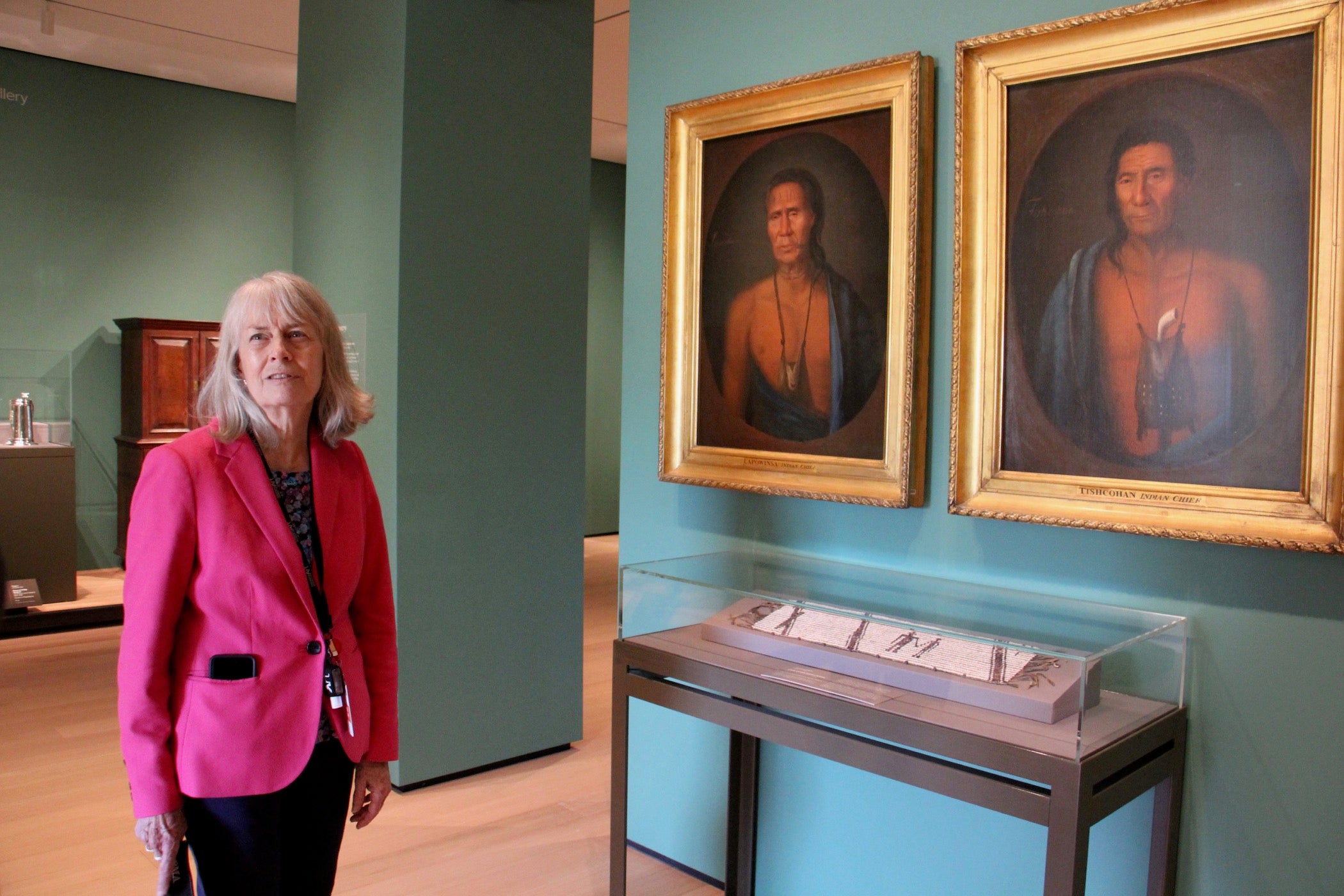
“The big addition is the art of Indigenous people. We have never had that as part of the PMA’s collection, so we had to go out and get some loans,” Foster said. “We were determined to have the representation of the original people in the Delaware Valley, of the Lenape people.”
Now, at the entrance of the new American galleries, visitors immediately come face-to-face with a pair of painted portraits of Lenape leaders Lapowinsa and Tishcohan. The portraits were painted in 1735 as part of the Lenape’s negotiations with the sons of William Penn over land. The wall text accompanying the portraits explains the resulting Walking Treaty was used by the sons of Penn to defraud the tribe out of land.
The original American galleries are still where they always have been in the museum. The new American galleries expand what Foster is able to show — including furniture, silverwork, and paintings — and the stories she is able to tell, including stories of Black Philadelphia.
“Philadelphia has always been a very big community of free Black artists, artists, and artisans. We wanted to emphasize that. We have a whole section that draws out that story,” she said. “We also are telling the story of slavery, which sometimes is invisible in the objects that you’ll see. You have to know that that object was made in a workshop that had enslaved workers in it.”
Across the forum from the new American gallery is the new contemporary space, a large series of galleries dedicated to work by living artists. It opens this weekend with “New Grit: Art and Philly Now,” a show of 25 artists either currently living in Philadelphia, originally from the city, or with strong ties here.

The work includes large-scale photography, video installation, fiber art, illuminated stained glass, sculpture, painting, neon, printing, and digitally collaged landscapes. Aside from two photos, none of the works came from the museum’s collection. Almost everything was borrowed from the artists themselves or from private collections.
Elisabeth Agro, curator of contemporary craft, said “New Grit” involved all the museum’s contemporary art curators from different artistic disciplines coming together to compile a list of local artists they wanted to include. The list had about 200 names, which they argued over until it came down to 25.
They include Roberto Lugo, a ceramist who incorporates his upbringing in Philadelphia’s Kensington neighborhood; Becky Suss who paints very bright, life-size domestic rooms with a flattened perspective; Peruvian artist Kukuli Velarde, whose works resembling pre-Columbian artifacts critiquing European colonialism; and “Be Alarmed: The Black Americans Epic, Movement 1 – the Visions,” an assemblage of photo and video projections by Tiona Nekkia McClodden.
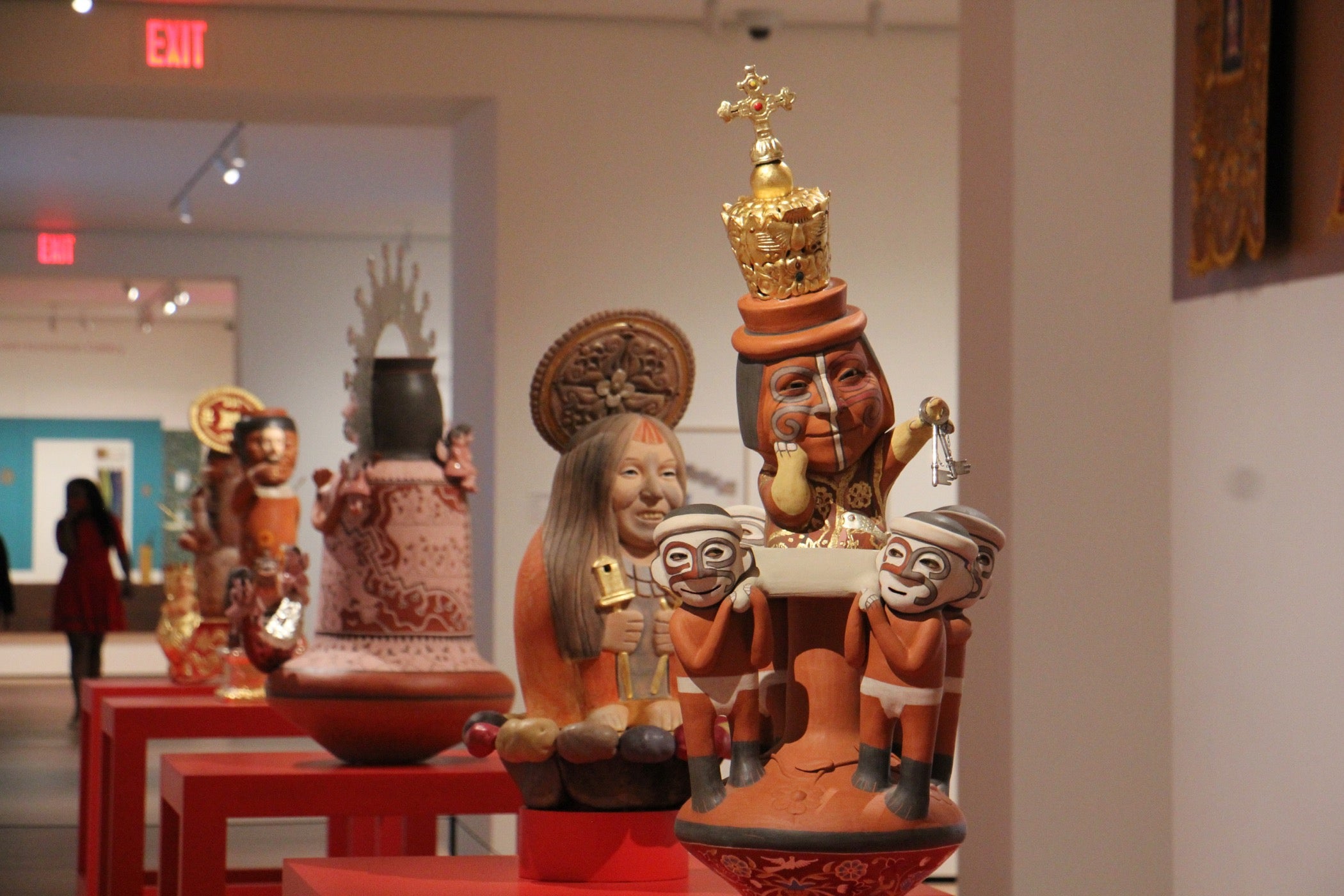
Argo said it was the first time all the contemporary curators worked together to create a single show.
“There were no hierarchies between the different silos within contemporary practice,” she said. “For someone who is the curator of contemporary craft, which usually is the pejorative of these art forms, the fact that I could play in the sandbox with my colleagues, and the work would be privileged as equal, is incredibly important.”
Argo believes such a collaborative project would not have been possible without the new 10,000-square-foot gallery space.
“I go by the mantra, things happen for a reason and they happen when they’re supposed to,” she said. “You couldn’t have picked a better nexus for this moment to happen here. Not that we didn’t want to work with each other, but it wasn’t in our practice. We were all siloed in our different departments. There was no place in which that could happen.”
Her colleague Peter Barberie, agrees. As curator of photography, he used to have a gallery along a sloped hallway that led from the coat check and bathrooms up to the museum restaurant.
“We used to call it the bowling alley,” he said.
Barberie said the new contemporary gallery, where curators can freely collaborate, will be a game-changer.
“Although Elizabeth and I will be the first to tell you that certain parts of the collection still need even more,” he said. “We’re going to be here to fight the good fight for that.”

Get daily updates from WHYY News!
WHYY is your source for fact-based, in-depth journalism and information. As a nonprofit organization, we rely on financial support from readers like you. Please give today.



